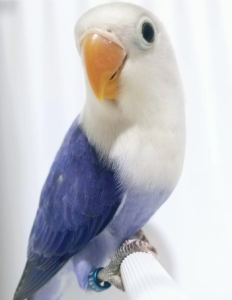violet fischer lovebird
The lovebird’s mutant variant is called violet Fischer and was derived from a small parrot species, namely Fischer’s lovebird from Tanzania, east Africa. Violet Fischer’s Lovebird is one of the best known and most desired pets in the pet trade because of its exotic violet/purple coloring. Here’s more information specifically about Violet Fischer’s Lovebirds:

Physical Characteristics:
Coloration: The distinctive characteristic about the lovebird is having a violet and plum color. Hence, this mutation is manifested by the entire uniform violet color covering the head, body, wings, and tail feathers. This is a dark violet color that ranges between a rich and a light lilac.
Beak and Feet: In all aspects, Violet Fischer’s Lovebird resemble the other Fischer’ Lovebird where they possess a curve beak and strong foot with claws used for feeding, climbing, or even manipulation.

Habitat and Distribution:
The lovebird belongs to the Violet Fischer’s Lovebirds which is actually the color variant of a different species from the African country, Mozambique. These particular habitats are found in certain areas of Tanzania, East Africa where these wild Fischer’s Lovebirds breed.
Diet:
Like with other varieties in this class, they will require similar diets. There are numerous types of them in wild where they feed on berries, leaves, seeds, flowers, bark, tubers and worms. To ensure good health in captivity, feed quality pellet food along with small quantities of fresh fruits and vegetables.
Behavior:
The behavior of Violet Fischer’s Lovebirds is similar to that of other Fischer’s Lovebirds:
Social Nature: These are very sociable birds and develop deep relationships with their mates and other birds they hangout with. Like humans, they display affectionate behavior by preening and mutual feeding.
Playful and Active: The are the highly mobile couples that appreciate playing around with different enrichments and toys as well. They are notorious for being mischievous as well as doing backflips etc.
Vocalizations: They can also sing like in the case of other love birds; making chirps and a number of sounds mostly in in the morning and evening.
Breeding:
However, a pair of breeding violet fischer should be established in captivity. In case they have required gene variations, their offspring may be born with violet pigmentation. Successful breeding depends on providing suitable nesting boxes, an appropriate environment, and good nutrition.
Conservation Status:
The violet Fischer’s lovebird is a separate color mutation of the Fischer’s lovebird and it doesn’t have its separate conservation status. While wild lovebird population is categorized as Near Threatened because of shrinking habitats and illegal capture for sale in pet trade. Their wild populations need conservation efforts to maintain them.
Lifespan:
Under good care, Violet Fischer’s lovebirds could survive beyond 15 to 20 years in domestication, as their wild-types.
Nurturing the lovebirds means feeding them (providing food), socializing with them, and giving them an entertainment setting. Buy your pet birds only from renowned breeders or rescue groups for ethical dealings in the bird trade as you always do.